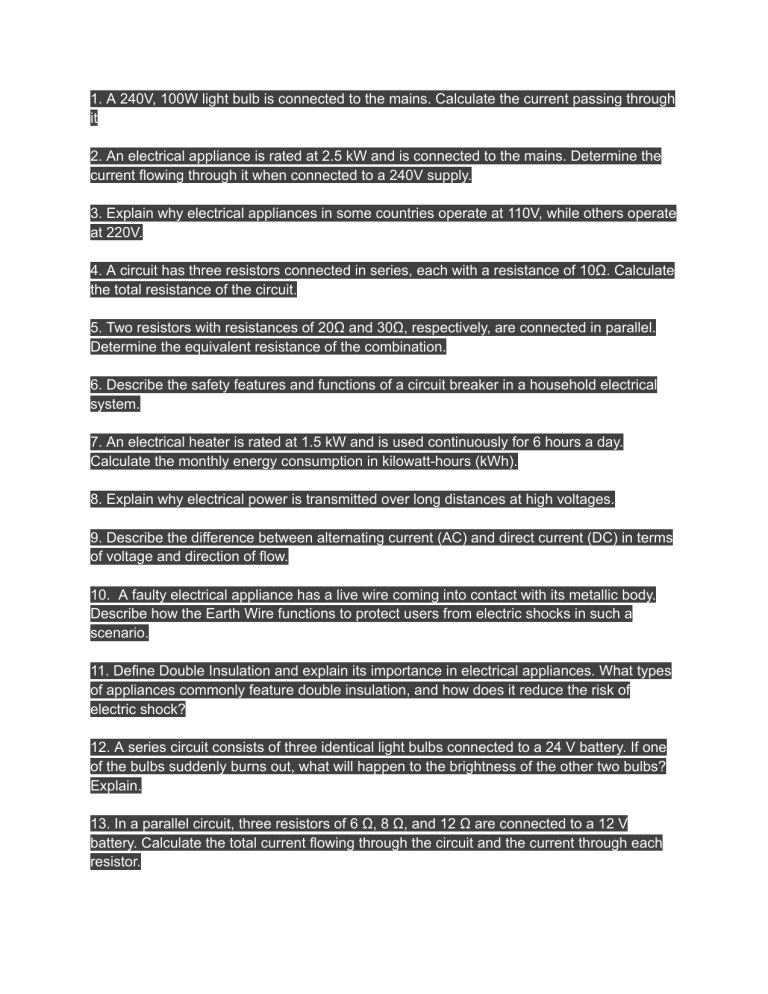
1. A 240V, 100W light bulb is connected to the mains. Calculate the current passing through it 2. An electrical appliance is rated at 2.5 kW and is connected to the mains. Determine the current flowing through it when connected to a 240V supply. 3. Explain why electrical appliances in some countries operate at 110V, while others operate at 220V. 4. A circuit has three resistors connected in series, each with a resistance of 10Ω. Calculate the total resistance of the circuit. 5. Two resistors with resistances of 20Ω and 30Ω, respectively, are connected in parallel. Determine the equivalent resistance of the combination. 6. Describe the safety features and functions of a circuit breaker in a household electrical system. 7. An electrical heater is rated at 1.5 kW and is used continuously for 6 hours a day. Calculate the monthly energy consumption in kilowatt-hours (kWh). 8. Explain why electrical power is transmitted over long distances at high voltages. 9. Describe the difference between alternating current (AC) and direct current (DC) in terms of voltage and direction of flow. 10. A faulty electrical appliance has a live wire coming into contact with its metallic body. Describe how the Earth Wire functions to protect users from electric shocks in such a scenario. 11. Define Double Insulation and explain its importance in electrical appliances. What types of appliances commonly feature double insulation, and how does it reduce the risk of electric shock? 12. A series circuit consists of three identical light bulbs connected to a 24 V battery. If one of the bulbs suddenly burns out, what will happen to the brightness of the other two bulbs? Explain. 13. In a parallel circuit, three resistors of 6 Ω, 8 Ω, and 12 Ω are connected to a 12 V battery. Calculate the total current flowing through the circuit and the current through each resistor. 14. A parallel circuit consists of two identical capacitors connected to a 200 V power supply. If one of the capacitors is removed from the circuit, what will happen to the total capacitance and the charge stored in the remaining capacitor? Explain. 15. A copper wire has a resistance of 2.0 Ω at 20°C. If the wire's temperature is raised to 100°C, calculate its new resistance. (Coefficient of resistivity of copper = 0.0039 Ω/°C) 16. An electric heater draws a current of 5.0 A when connected to a 240 V supply. Calculate the power rating of the heater. 17. Two resistors, R1 and R2, are connected in series. If R1 is 6.0 Ω and R2 is 4.0 Ω, determine the equivalent resistance of the combination. 18. In a parallel circuit, three resistors with resistances of 3.0 Ω, 4.0 Ω, and 6.0 Ω are connected to a 12 V battery. Calculate the total current flowing through the circuit. 19. A circuit contains two resistors in parallel: R1 = 8.0 Ω and R2 = 12.0 Ω. The total current in the circuit is 5.0 A. Calculate the potential difference across each resistor. 20. An electric iron is rated 1.5 kW when operated at 220 V. Calculate the resistance of the iron's heating element. 21. Explain the difference between fixed resistors and variable resistors, giving examples of their practical applications. 22. Discuss the working principle of a thermistor and its applications in temperature measurement and control systems. 23. Explain the principle behind a Van de Graaff generator and its application in generating high voltages. 24. Discuss the process of charging by friction and provide examples of everyday situations where it occurs. 25. Explain the process of grounding and its role in electrical safety. 26. Describe the working principle of an electroscope and how it can be used to detect electric charge. 27. Explain the challenges faced by the aviation industry due to static electricity during aircraft refueling and suggest safety protocols to address them. 28. Describe real-world applications of static electricity and its beneficial use in industries such as painting and printing. 29. Explain the concept of a diode and its fundamental purpose in an electronic circuit. 30. Analyze the operation of a light-emitting diode (LED) and its advantages over traditional light sources.









